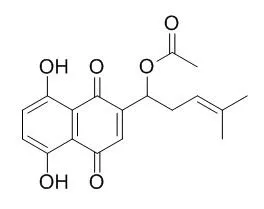| In vitro: |
| Eur J Pharmacol. 2014 Jul 15;735:132-40. | | Acetylshikonin induces apoptosis of hepatitis B virus X protein-expressing human hepatocellular carcinoma cells via endoplasmic reticulum stress.[Pubmed: 24769509] |
METHODS AND RESULTS:
When Acetylshikonin was added to Hep3B cells stably expressing HBX, it induced apoptosis in a dose-dependent manner. Acetylshikonin induced upregulation and export of Nur77 to the cytoplasm and activation of JNK. Likewise, suppression of Nur77 and JNK inactivation protected the cells from Acetylshikonin-induced apoptosis, indicating that Nur77 upregulation and JNK activation were required for Acetylshikonin-mediated apoptosis. Furthermore, Acetylshikonin increased the expression of Bip and ubiquitination levels of cellular proteins, features of endoplasmic reticulum (ER) stress, via the production of reactive oxygen species in a dose-dependent manner. Suppression of reactive oxygen species with N-acetylcysteine reduced levels of Bip protein and ubiquitination levels of cellular proteins during Acetylshikonintreatment, leading to protection of cells from apoptosis. Cycloheximide treatment reduced Acetylshikonin-induced ER stress, suggesting that protein synthesis is involved in Acetylshikonin-induced ER stress. Moreover, we showed using salubrinal, an ER stress inhibitor that reactive oxygen species production, Acetylshikonin activation, and Nur77 upregulation and its translocation to cytoplasm are necessary for ER-induced stress. Interestingly, we found that JNK inactivation suppresses Acetylshikonin-induced ER stress, whereas Nur77 siRNA treatment does not, indicating that JNK is required for Acetylshikonin-induced ER stress.
CONCLUSIONS:
Accordingly, we report that Acetylshikonin induces ER stress, which is prerequisite for apoptosis of HBX-expressing hepatocellular carcinoma cells. | | Evid Based Complement Alternat Med. 2013;2013:937370. | | Acetylshikonin, a Novel AChE Inhibitor, Inhibits Apoptosis via Upregulation of Heme Oxygenase-1 Expression in SH-SY5Y Cells.[Pubmed: 24302971] | Acetylcholinesterase inhibitors are prominent alternative in current clinical treatment for AD patients. Therefore, there is a continued need to search for novel AChEIs with good clinical efficacy and less side effects.
METHODS AND RESULTS:
By using our in-house natural product database and AutoDock Vina as a tool in docking study, we have identified twelve phytochemicals (emodin, aloe-emodin, chrysophanol, and rhein in Rhei Radix Et Rhizoma; xanthotoxin, phellopterin, alloisoimperatorin, and imperatorin in Angelicae dahuricae Radix; shikonin, Acetylshikonin, isovalerylshikonin, and β,β-dimethylacrylshikonin in Arnebiae Radix) as candidates of AChEIs that were not previously reported in the literature. In addition to AChEI activity, a series of cell-based experiments were conducted for the investigation of their neuroprotective activities. We found that Acetylshikonin and its derivatives prevented apoptotic cell death induced by hydrogen peroxide in human and rat neuronal SH-SY5Y and PC12 cells at 10 μM.
CONCLUSIONS:
We showed that Acetylshikonin exhibited the most potent antiapoptosis activity through the inhibition of the generation of reactive oxygen species as well as protection of the loss of mitochondria membrane potential. Furthermore, we identified for the first time that the upregulation of heme oxygenase 1 by Acetylshikonin is a key step mediating its antiapoptotic activity from oxidative stress in SH-SY5Y cells. |
|






 Cell. 2018 Jan 11;172(1-2):249-261.e12. doi: 10.1016/j.cell.2017.12.019.IF=36.216(2019)
Cell. 2018 Jan 11;172(1-2):249-261.e12. doi: 10.1016/j.cell.2017.12.019.IF=36.216(2019) Cell Metab. 2020 Mar 3;31(3):534-548.e5. doi: 10.1016/j.cmet.2020.01.002.IF=22.415(2019)
Cell Metab. 2020 Mar 3;31(3):534-548.e5. doi: 10.1016/j.cmet.2020.01.002.IF=22.415(2019) Mol Cell. 2017 Nov 16;68(4):673-685.e6. doi: 10.1016/j.molcel.2017.10.022.IF=14.548(2019)
Mol Cell. 2017 Nov 16;68(4):673-685.e6. doi: 10.1016/j.molcel.2017.10.022.IF=14.548(2019)